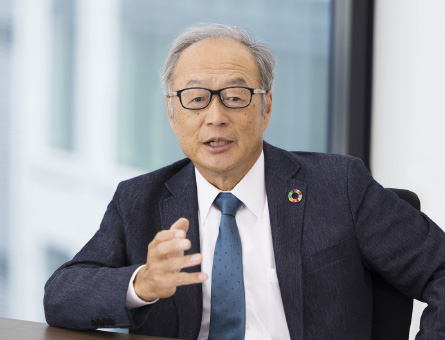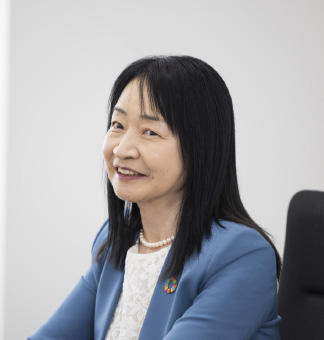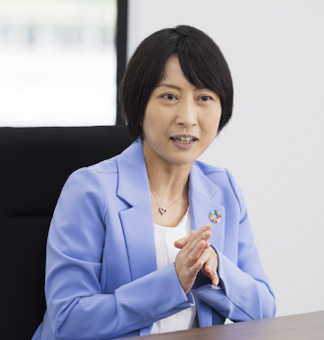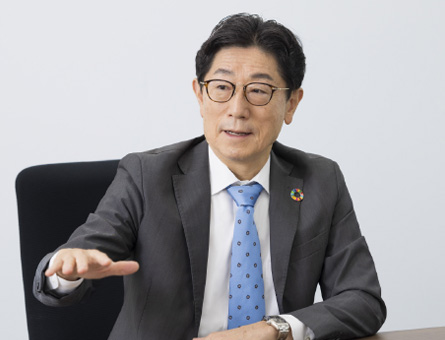Towards the sustainable enhancement of TAIYO YUDEN's value
TAIYO YUDEN aims to achieve sustained growth and enhance corporate value over the medium- to long-term and is therefore continuing to strengthen its corporate governance structure. Outside directors Masashi Hiraiwa, Seiichi Koike, Emiko Hamada, and Tomomi Fujita recently sat down to discuss the Company's transition to a company with an Audit & Supervisory Committee, its initiatives on human capital, and the progress of the medium-term management plan 2025.
-
 Outside DirectorSeiichi Koike
Outside DirectorSeiichi Koike -
 Outside DirectorEmiko Hamada
Outside DirectorEmiko Hamada -
 Outside Director Audit & Supervisory Committee MemberTomomi Fujita
Outside Director Audit & Supervisory Committee MemberTomomi Fujita -
 Outside DirectorMasashi Hiraiwa
Outside DirectorMasashi Hiraiwa
Transition to a company with an Audit & Supervisory Committee
Discussions leading up to the transition and changes in governance thereafter
Hiraiwa: This year, the Company transitioned from being a company with an Audit & Supervisory Board, to one with an Audit & Supervisory Committee. We started talking about the change in institutional design in around FY2021 when the current medium-term management plan 2025, which calls for net sales of ¥480 billion, kicked off.
When a company grows larger, a different style of corporate governance that is more suitable is naturally required. As outside directors, we discussed on many occasions that it would probably not be good to continue with the previous structure. Also, as a sign of the changing times, there have been increasingly stronger calls for companies to shift from a "management" model in which a company's board of directors is seen as the highest decision-making body when it comes to business execution, to a "monitoring" model, where the board serves as a supervisory body overseeing business execution.
The governance structure of "a company with Nomination Committee, etc." was also an option, but given that Japan is currently grappling with a shortage of outside directors, it was decided that the best solution to meet the needs of the Company at this point would be to transition to a company with an Audit & Supervisory Committee.
Hamada: As with many traditional Japanese companies, TAIYO YUDEN had operated under the so-called "management" model, so I also think that adopting the governance structure of "a company with an Audit & Supervisory Committee," under which the balance between oversight and execution can be set more flexibly, is more suited to the Company than the Nomination Committee-based structure, where oversight and execution are clearly separated. From now on, we will aim to have the Board of Directors be more "monitoring" oriented by promoting the delegation of authority. In my view, we are currently at the stage of shaping a Board structure that is best for the Company to make further progress.
Koike: During the discussions about this change in institutional design, we were able to debate various points related to governance, starting with the purpose of transitioning to a company with an Audit & Supervisory Committee, the role of the Board of Directors, and the Board's skills matrix. I think it was meaningful for the Company that we were given an opportunity to reflect on the basics of corporate governance.
Since the change, the Board's independence and diversity has increased, with outside directors now making up 50% of the Board and women comprising 30%. I also think the nature of discussions at Board meetings will change significantly up ahead. I hope that the Board will now be able to thoroughly discuss a wide range of issues for which previously there was not enough time available for deliberation.
Hiraiwa: In order to further streamline management, which was one of the objectives of the change in institutional design, amendments were made to the Company's Articles of Incorporation and Board regulations so that decision-making authority on important matters of business execution could be delegated to the executive directors. Discussions and resolutions regarding delegated matters will now be addressed at Management Committee meetings, TM (Top Management) meetings, and other meeting bodies, which allows the Board of Directors to focus more on discussions about the Company's basic policies and management strategies.
On the other hand, how we go about supervising the content of delegated authority will present a new challenge to us as outside directors. To properly supervise from a distance the matters that used to be discussed at Board meetings, we will need to demonstrate even greater sensitivity than before. In that sense, of all the outside directors, the role has changed the most for those who serve as members of the Audit & Supervisory Committee, including Ms. Fujita.
Fujita: With this transition, my position has shifted from being an Audit & Supervisory Board member to being a director who also serves as an Audit & Supervisory Committee member. As part of this, there have been two major changes.
The first is the way in which I engage with the Board of Directors. Previously, my role as an Audit & Supervisory Board member was to audit the execution of business operations, and while I participated in Board meetings, I had no voting rights. In my new position, however, I now hold voting rights as a director and participate in Board resolutions, while also taking on the added responsibility of overseeing the execution of business operations.
The other change is in the way audits are conducted. Having switched from being a sole auditor (Audit & Supervisory Board member) to a member of the Audit & Supervisory Committee, I now need to perform organizational audits. Going forward, each member of the Audit & Supervisory Committee will no longer be conducting their own audits separately. Instead, all of us on the Committee will need to collaborate closely with business divisions, the Internal Control Committee, and the Internal Audit Office to ensure that the entire organization is operating smoothly. In addition, we plan to establish a system for collaborating with the auditors of the Company's subsidiaries when undertaking audits. I hope to explore ways to maintain close communication with various departments and organizations in a bid to discover better auditing methods.
Evaluation of the effectiveness of the Board of Directors
Investments in human capital tied to management strategy
Hamada: At TAIYO YUDEN, the effectiveness of the Board of Directors is evaluated with the use of a questionnaire. Looking back, I believe the effectiveness of the Board has been improving, because we have been able to confirm how the PDCA cycle has been implemented for the topics discussed by the Board every year.
A topic that we have continually discussed in recent years is investments in human capital tied to management strategy. In FY2023 too, we discussed this topic from various angles.
Koike: More specifically, we have referenced certain data to advance discussions on such matters as employee training, the latest information about the succession plan for directors and officers, work engagement issues, progress on appointing female managers, and investments in human capital. I believe we have made steady progress on discussing issues related to human capital.
Hiraiwa: These days, companies are being urged to disclose information about human capital in various situations. For example, the disclosure of sustainability information is now required in securities reports. Accordingly, the Company considers climate change and human capital to be important issues and recognizes human capital as one of the indispensable elements in its sustainable development.
So, what can be done to strengthen human capital? For TAIYO YUDEN right now, the most important thing is to add depth to its human capital. Currently, the Company has a shortage of young employees. As a measure to address this, it continues to hire a certain number of new graduates each year. The next thing is that it needs candidates with the potential to join the senior management team in the future, so to that end, the Company is running executive candidate training for about 300 people across the entire Group. It is my understanding that the building of a sustainable foundation by first strengthening the layers of human capital is the cornerstone of TAIYO YUDEN today. This is the first step to enhancing human capital and an approach that is progressing steadily. On the other hand, we will need to deepen our discussions about how all of this connects to the Company's management strategies.
Hamada: I think it is fair to say that the Company has been able to nurture human resources linked to its business strategies by doing what Mr. Hiraiwa just mentioned—hiring new graduates and developing executive candidates. If the direction of management continues as a natural line of extension seen thus far, it may be deemed sufficient.
That said, when viewed from the perspective of management strategy rather than business strategy, it is an entirely different matter. There are some key points that need to be considered in this regard. Namely, does the Company have the capacity to overcome significant changes in the external environment? Does it have the resources to establish new pillars of business? For instance, does it have the personnel capable of successfully executing M&As to acquire new management resources? As we look ahead to the next medium-term management plan, as well as 10 years from now and even beyond that, how the Company readies itself with human capital will continue to be a theme that ought to be discussed.
Value creation in the medium to long term
Progress of the medium-term management plan 2025
Koike: In its medium-term management plan 2025, the Company set the following economic value-related KPI targets: net sales of ¥480 billion; operating margin of 15% or higher, ROE of 15% or higher, and ROIC of at least 10%. The final year of the plan, FY2025, is just around the corner, and achieving these targets will prove challenging. On the other hand, I think the Company is making relatively solid progress on the KPIs related to social value that it set for the purpose of enhancing sustainability, specifically the indicators mainly for GHG emissions and the female manager ratio.
Hamada: I dare say that when looking at the indicators related to economic value, the actual results in FY2023 were very underwhelming. One reason for that was the tougher-than-expected external environment. However, we should not blame the poor performance in FY2023 entirely on external factors. For example, if the Company could catch the signs of a changing tide earlier, or if it could further break down the needs of each market to identify issues and take action accordingly, it might be able to alleviate the impact of external factors. The Company's executives have reflected on this, recognized the challenges, and are working on the measures required, so I have high hopes they will be able to minimize the negative impacts from the external environment in the future.
Fujita: Regardless of the direction of future technological advancements, I believe the electronic components manufactured by the Company are indispensable to society and that the business itself offers society a lot of value. While the conditions are tough, I believe TAIYO YUDEN will implement measures for achieving the medium-term management plan 2025, and even beyond that, it will set its sights on being a company that contributes to society by making high-quality products.
Hiraiwa: During the period of the medium-term management plan 2025, numerous unforeseen events occurred, such as the COVID-19 pandemic and the situation between Russia and Ukraine. On top of that, the Company experienced a crisis during which growth in its mainstay product of multilayer ceramic capacitors stagnated due to a worsening external environment. Nevertheless, facing that crisis forced the Company to adapt its response to the external situation, and we could say that it gained valuable experience in doing so within a tight timeframe.
How we leverage this experience going forward will be key. In the process of developing the next medium-term management plan, it will be important for the Company to anticipate the future and take action through collaboration across the whole organization, not just within departments, so that this experience does not go to waste, mainly by working out how to respond if similar situations arise and how much it can evolve its ability to read the market.
The Board of Directors will also make the necessary preparations for the Group to advance to the next stage. The structure of the Board has been largely transformed by the change in institutional design, but what is important is what lies beyond that. As outside directors, we will continue to pursue the most optimal governance structure for the Group in order to achieve the goals of the medium-term management plan 2025 and to prepare for the start of the next plan.

